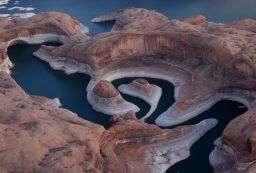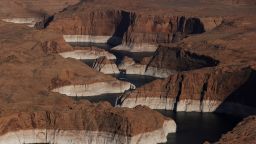For the first time since it was filled more than 50 years ago, Lake Powell, the second-largest reservoir in the country, is projected to dip past a critical threshold, threatening water supplies and putting a key source of hydropower generation at heightened risk of being forced offline, as climate change-fueled drought continues to grip the Western US.
The US Bureau of Reclamation told CNN it is currently anticipating water levels in Lake Powell to reach a significant elevation of 3,525 feet above sea level sometime between March 10 and 16.
Drought contingency plans define the 3,525-foot mark as a significant “target elevation” for the reservoir, under which the situation becomes dire. As of Thursday, Lake Powell had fallen to just over 3,526 feet in elevation, which is just over 24% of capacity and less than two feet away from the critical level.

“We’re kind of in some uncharted territory, socially and economically,” Justin Mankin, assistant professor of geography at Dartmouth College and co-lead of the National Oceanic and Atmospheric Administration’s Drought Task Force, told CNN. “It’s totally within reason to expect that the next couple of weeks or so for [Lake Powell] to fall below the critical level.”
Lake Powell’s plunging water level threatens Glen Canyon Dam’s capacity to produce hydropower, much like Lake Mead and Hoover Dam. Glen Canyon Dam provides power for many states including Wyoming, Utah, Colorado, New Mexico, Arizona, Nevada, and Nebraska.
The 3,525-foot target is crucial because it allows a 35-foot buffer for emergency response to prevent Lake Powell from dropping below the minimum pool elevation of 3,490 feet above sea level, the lowest at which Glen Canyon Dam is able to generate hydropower.
Lake Powell and nearby Lake Mead, the nation’s largest reservoir, have drained at an alarming rate in the last year. In August, the federal government declared a water shortage on the Colorado River for the first time after Lake Mead’s water level plunged to unprecedented lows, triggering mandatory water consumption cuts for states in the Southwest which began in January.
The significance of the dwindling supply in the two reservoirs, fed by the Colorado River watershed, cannot be overstated. Water flowing down the Colorado River fills both Powell and Mead, which are part of a river system supplying more than 40 million people living across seven Western states and Mexico. Both reservoirs provide a critical supply of drinking water and irrigation for many across the region, including rural farms, ranches and native communities.
The low water levels in the critical reservoirs, according to Mankin, only “amplifies inequities” across the Western states, where the “poorest cultivators and those who have the least senior water rights are not going to get any water,” he said.
The ‘central bank’ of the Colorado River
For months, Western water managers have tried to prevent the worst-case scenario from happening.
Last summer, they made emergency releases from other upstream reservoirs across the region including the Blue Mesa, Flaming Gorge and Navajo reservoirs. The water transfer made levels in Colorado’s Blue Mesa drop by 8 feet, forcing an early end to the region’s boating season which was detrimental to the local economy.

Once Lake Powell drops below 3,525 feet, the Bureau of Reclamation would have to release more water from the smaller reservoirs once the spring snow melt dwindles toward the end of the summer, as part of the 2019 Colorado River Drought-Contingency Plan to keep it afloat.
“It’s kind of like the central bank of an economy, drawing money from local banks to kind of keep the economy afloat,” Mankin said. “Lake Powell is the central bank of the Colorado River Basin. Maybe that’s workable for a little while, but just like a household, the longer it’s in debt, the harder it gets. And it’s really the same thing with these reservoirs.”
Monthly water releases are essential to keeping the reservoir’s elevation from dropping below the target level through the winter months until spring runoff materializes. Water managers are expecting Lake Powell’s water levels to rise back up above 3,525 feet as a result of spring runoff season; however, drought conditions might cause it to plunge back down again.
“The effects of Lake Powell dipping below its critical threshold in spring could reverberate through the states reliant on that water months down the road,” Mankin said, pointing to impacts in Glen Canyon’s capacity to deliver hydropower, “given the propensity for the American West to suffer some pretty gnarly heat waves.”
Water managers were hopeful when the 2022 water year got off to a promising start, after the Colorado River Basin experienced a wetter-than-normal October, but the very next month saw the second-driest November on record, quickly diminishing the outlook. Lake Powell lost around 1.5 million acre-feet of inflow in November, according to the Bureau of Reclamation.
Across many parts of the West, the latest US drought monitor update shows the promising early-season snowpack “flatlining” during January and February. In California, a recent snow survey from the state Department of Water Resources showed reservoirs across the state will likely not fill up again this year.
It may also be the case for the Colorado River basin. While it recently experienced substantial snowpack, the critically low water levels in reservoirs, coupled with the uncertainty of future snowpack, might require unprecedented action from governments.
If future projections show the monthly releases are not enough to protect Lake Powell, the Bureau of Reclamation will need to consider other avenues. At the moment, the agency and the Upper Basin states are continuing to work on a Drought Response Operations Plan, which they expect to complete this April.
But given the rate at which the planet is rapidly warming, Mankin worries about the potential aftermath recovery process: “Then what? Do we go back to kind of normal operations?” he said. “I feel a bit nervous about the fact that the climate is changing, but our management of water is not.”
Climate change’s impacts on water in the West may just be a preview of what’s to come.
Around half of the world’s population already experiences severe water scarcity each year in part due to climate-related factors, a major UN report released Monday said. It also concluded as many as three billion people around the world will experience “chronic water scarcity” under uncontrolled global warming.
“The drought is pretty baked in,” Mankin said. “My expectation is fully that the American West is going to be in a drought through the rest of this year, at the very least. To recover from this thing, we’re talking about multiple seasons of above-average precipitation.”





